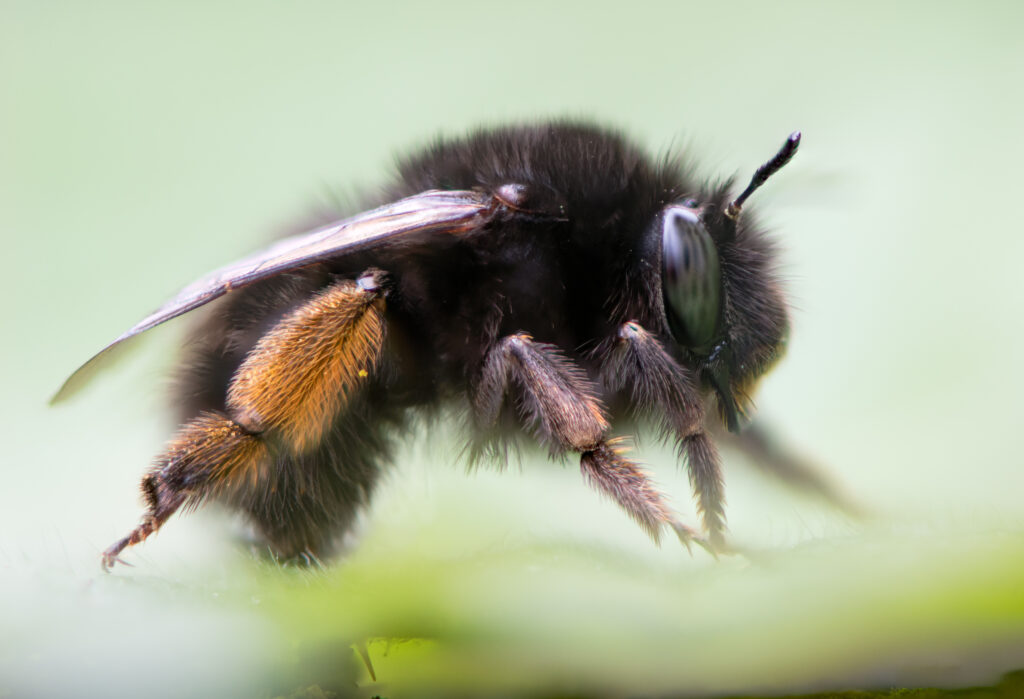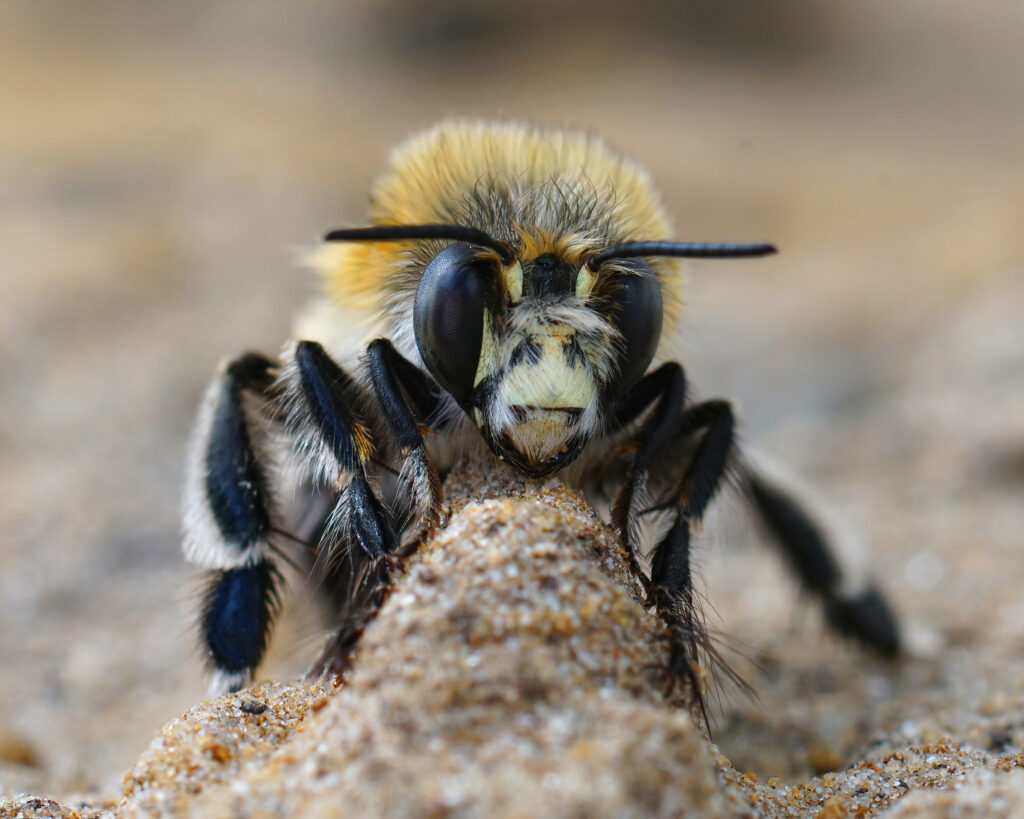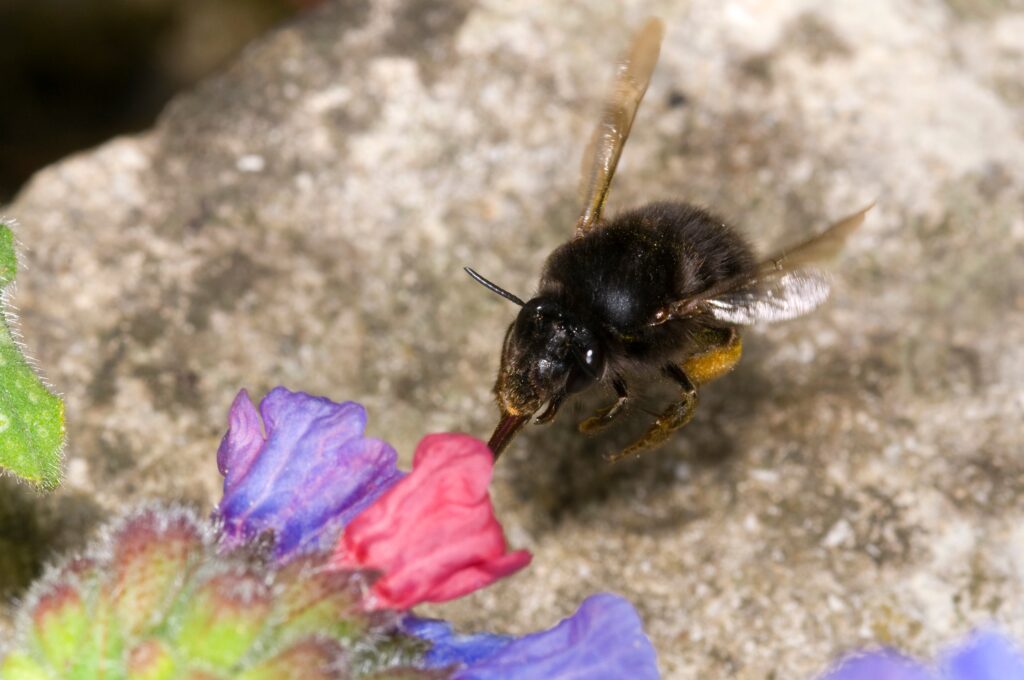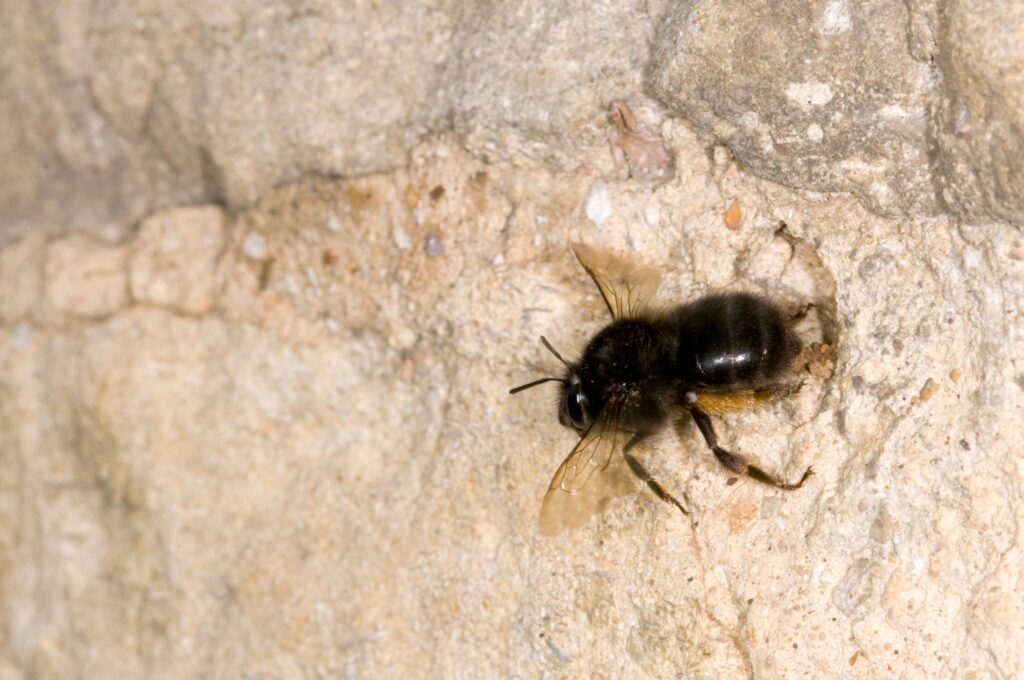Hairy-footed Flower Bee
Anthophora plumipes
the hairy-footed flower bee has conspicuous, dense tufts of hair on its hind legs.
Advertisement
Hairy-footed Flower Bee Scientific Classification
- Kingdom
- Animalia
- Phylum
- Arthropoda
- Class
- Insecta
- Order
- Hymenoptera
- Family
- Apidae
- Genus
- Anthophora
- Scientific Name
- Anthophora plumipes
Read our Complete Guide to Classification of Animals.
Hairy-footed Flower Bee Conservation Status
Hairy-footed Flower Bee Facts
- Prey
- N/A
- Main Prey
- N/A
- Name Of Young
- larvae
- Group Behavior
- Solitary
- Fun Fact
- the hairy-footed flower bee has conspicuous, dense tufts of hair on its hind legs.
- Estimated Population Size
- undetermined
- Biggest Threat
- habitat loss, pesticides
- Most Distinctive Feature
- hairy bodies
- Distinctive Feature
- females are predominantly black.
- Other Name(s)
- N/A
- Gestation Period
- 5-7 days
- Temperament
- mild
- Wingspan
- 0.86 - 1.0 inches (22 to 26 mm)
- Training
- N/A
- Optimum pH Level
- N/A
- Incubation Period
- 5-7 days
- Age Of Independence
- At emergence
- Age Of Fledgling
- N/A
- Average Spawn Size
- 1-10
- Litter Size
- N/A
- Habitat
- meadows, parks, gardens
- Predators
- birds, spiders, other insects
- Diet
- Herbivore
- Average Litter Size
- N/A
- Lifestyle
- Diurnal
- Favorite Food
- tubular flower nectar
- Type
- Anthophora plumipes
- Common Name
- Hairy-footed flower bee
- Special Features
- hairy tufts on hind legs
- Origin
- Europe
- Number Of Species
- 530
- Location
- Widespread distribution
- Slogan
- N/A
- Group
- N/A
- Nesting Location
- ground, mortar between stones or bricks
- Age of Molting
- various times throughout larval stage
Hairy-footed Flower Bee Physical Characteristics
- Color
- Yellow
- Black
- Dark Brown
- Cream
- Orange
- Skin Type
- Exoskeleton
- Lifespan
- 3 weeks- 1 year
- Weight
- less than 1 ounce
- Height
- 0.1-0.2 inches
- Length
- 0.4 - 0.6 inches (11-16 mm)
- Age of Sexual Maturity
- 1-3 days post emergence
- Age of Weaning
- N/A
- Venomous
- No
- Aggression
- Low
View all of the Hairy-footed Flower Bee images!
Welcome to the fascinating world of the hairy-footed flower bee (Anthophora plumipes), a tiny but mighty pollinator that is a true friend to many flowers. This little bee may be small in size, but it plays a big role in maintaining the health and beauty of the natural world. The hairy-footed flower bee is a native species in Europe and North Africa. It has a wide distribution and can be found from the Iberian Peninsula in the west to the Middle East and Central Asia in the east. In recent years, it has also been introduced to parts of North America, including Canada and the United States. The genus Anthophora contains over 550 recognized species. Keep reading to learn more about this enchanting and important insect and discover the many ways in which it contributes to the delicate balance of life on Planet Earth.

This little bee may be small in size, but it plays a big role in maintaining the health and beauty of the natural world!
©IanRedding/Shutterstock.com
Hairy-footed Flower Bee: Scientific Name
In the field of biological taxonomy, species have two names: the genus name and the species descriptive. In the binomial scientific name for hairy-footed flower bees, Anthophora plumipes, the first word represents the genus, while the second word, plumipes, is the word that describes the species. Most names are Latin or Greek based. Anthophora is derived from two Greek words, anthos meaning flower, and phorein meaning to bear or carry. Therefore, Anthophora translates to flower carrier or one who bears flowers. This is a suitable name for the genus, as they actively visit and collect nectar and pollen from flowers.
Plumipes is derived from two Latin words, pluma meaning feather or plume, and pes meaning foot. Therefore, plumipes translates to feather-footed. This is a fitting moniker as the hairy-footed flower bee has conspicuous, dense tufts of hair on its hind legs. These hairy legs give the impression of feathered feet and are an adaptation that allows the feather-footed flower carrier to efficiently collect and transport pollen.

The hairy legs are an adaptation that allows
Anthophora plumipesto efficiently collect and transport pollen.
©HWall/Shutterstock.com
Hairy-footed Flower Bee: Appearance
Anthophora plumipes is a medium-sized bee. Females are slightly longer at 0.5-0.6 inches (13-16 mm) than males at 0.4-0.55 inches (11-14 mm). The average wingspan of the Hairy-footed Flower Bee is between 0.86 – 1.0 inches (22 to 26 mm). The wingspan is the measurement taken from the tip of one wing to the tip of the other wing when the wings are fully extended. Female Anthophora plumipes have predominantly black bodies, covered in black setae (singularly seta). Setae are bristly hairs. The females have yellow-to-orange tufts of setae on their hind legs. Males have yellowish or cream-colored hairs (setae) on their backs and their legs. These setae are what make hairy-footed flower bees outstanding pollinators.
Anthophora plumipes have long tongues that they use to reach deep into flowers to gather nectar. They have large eyes that enable them to navigate and locate flowers. They also have transparent wings that beat rapidly, enabling them to fly and hover with great agility.

have long tongues that they use to reach deep into flowers to gather nectar.
©Wildwater.tv/Shutterstock.com
Behavior
Anthophora plumipes are solitary bees. They do not live in colonies or have castes. They are also not aggressive and rarely sting humans unless provoked or threatened. In terms of nesting behavior, females construct nests that consist of a series of brood cells. She provisions each cell with a supply of pollen and nectar for her developing larvae. When the brood cells are complete, the female hairy-foot deposits one egg in each cell. After each egg has been deposited and each brood cell has been sealed, the female bee seals the entrance to the nest and moves on to create another. Interestingly, the female determines the sex of her offspring. Fertilized eggs produce females, while unfertilized eggs produce males. Haplodiploidy is characteristic across the order of Hymenoptera.
As pollinators, hairy-footed flower bees are active foragers and can often be seen visiting flowers and gathering nectar and pollen. They have long tongues that allow them to reach the nectar deep within flowers, and they use their hairy legs to collect and transport pollen to their nests.
The hairy-footed flower bee hovers and darts. These little bees will hover in front of flowers before darting quickly into the flower to gather nectar and pollen. The hairy-footed flower bee emerges in the spring earlier than most other bee species. They are important spring pollinators of fruit trees and willow.
Hairy-footed Flower Bee: Strawberry Study
A study in Japan evaluated the pollination efficiency of the hairy-footed flower bee for greenhouse strawberries. The researchers used three treatments: hand pollination, open pollination, and bee pollination by Anthophora plumipes. The results showed that the bee-pollinated flowers had significantly higher fruit set and larger fruit size compared to hand-pollinated or open-pollinated flowers. The study concluded that hairy-footed flower bees are effective pollinators for greenhouse strawberries, offering a promising alternative to honey bees for crop pollination.
Diet
The hairy-footed flower bees’ generalist foraging behavior makes them important and versatile pollinators. They are not finicky when it comes to flower nectar, which is part of what makes them such amazing pollinators. Anthophora plumipes will visit a variety of flowers to gather nectar and pollen. As generalist foragers, hairy-footed flower bees play an important role in pollinating a diverse range of plant species. They are active early in the spring, making them key pollinators for early blooming flowers. However, they visit a wide range of plants, including fruit trees, willow, blackthorn, and clover. They do have a preference for tubular flowers like harebell (Campanula rotundifolia), lily-of-the-valley (Convallaria majalis), and foxglove (Digitalis purpurea).
Habitat
Anthophora plumipes can be found in a variety of habitats, including gardens, parks, meadows, and woodland rims. They prefer areas that have a good supply of nectar and pollen, as well as nesting sites that are easy to excavate, such as loamy/sandy soil banks. Anthophora plumipes are habitat generalists. They can adapt to different types of environments and use a variety of nesting materials. However, they tend to prefer areas with a mix of vegetation and bare ground, as this provides a good diversity of forage and nesting sites. From urban areas to natural landscapes, as long as there are suitable nesting sites and a good supply of flowers for foraging, the hairy-footed flower bee is right at home.
Anthophora plumipes are ground nesters. Ground nesting is a common characteristic of many species of solitary bees, as ground nests provide a safe and protected environment for developing larvae. The soil helps regulate temperature and moisture levels, while the tunnels provide a physical barrier against predators and parasites. As suitable natural habitats and nesting sites diminish, Anthophora plumipes have turned to other nesting materials, such as the loose mortar in crumbling walls, particularly in urban areas where soil is less available. So while they are principally ground nesters, they are adaptable.

As suitable natural habitats and nesting sites diminish,
Anthophora plumipeshave turned to other nesting materials, such as the loose mortar in crumbling walls, particularly in urban areas where soil is less available.
©Wildwater.tv/Shutterstock.com
Hairy-footed Flower Bee: Predators and Threats
Predators
Anthophora plumipes are vulnerable to predation from a range of animals, including birds, spiders, and other insects. Flycatchers, shrikes, warblers, and sparrows will nosh on a hairy-footed flower bee given the chance. In some cases, larger birds such as woodpeckers and jays have been known to eat bees. Crab spiders (family Thomisidae), jumping spiders (family Salticidae), and orb-weaver spiders (family Araneidae), will either ambush these bees as they are foraging or snare them in their webs. Parasitoids are insects that lay their eggs on or inside the body of another insect (host), which is eventually killed by the developing parasitoid larvae. Parasitoid wasp species that are known to attack bees include cuckoo wasps (family Chrysididae), velvet ants (family Mutillidae), and ichneumon wasps (family Ichneumonidae).
Threats
Anthophora plumipes face a number of threats and predators. Habitat loss from destruction and degradation reduces the availability of suitable nesting sites and forage resources for Anthophora plumipes, making it harder for them to survive and reproduce. Exposure to pesticides and other agricultural chemicals is harmful to these little pollinators, particularly neonicotinoids, nicotine-based insecticides that cause bee paralysis. The hairy-footed flower bee is also susceptible to an array of parasites and diseases.
Hairy-footed Flower Bee: Conservation Status and Population
There is limited population data available specifically for Anthophora plumipes, but it is generally considered to be a common and widespread species. The International Union for Conservation of Nature (IUCN) does not have a conservation status assessment for Anthophora plumipes, likely because it is not considered to be a threatened species. Anthophora plumipes is affected by habitat loss and fragmentation and pesticide use. In some regions of the United Kingdom, the species has become increasingly common in urban areas, where it nests in the soft mortar of crumbling walls. Nesting in human-altered environments is a necessary evolutionary adaptation for these important pollinators.
Hairy-footed Flower Bee: Lifecycle
The lifecycle of the yellow-footed flower bee begins with the emergence of adult bees from their underground nests in late winter or early spring. They have spent the winter in diapause, snug in their cocoons, The males emerge first and wait near the nesting sites for the females to emerge. Once the females emerge, the males compete for their attention, performing elaborate flight displays and releasing pheromones to attract them.
After mating, females begin the search for suitable nesting sites, usually in sandy or well-drained soil. Using her powerful mandibles, she excavates a tunnel in the soil, creating a series of cells where she will deposit her eggs. The female then collects and provisions each cell with a mixture of pollen and nectar, which will provide a food source for her developing larvae. The eggs hatch into larvae, which feed on the pollen and nectar provided by their mother. As the larvae grow and develop, they molt several times before spinning a cocoon and entering the pupal stage. After a period of time, the adult bee emerges from the cocoon and chews its way out of the underground nest.
The entire lifecycle of Anthophora plumipes takes approximately one year. The bees spend the majority of their time underground as larvae and pupae. Adult bees only live for a few weeks or months, during which time they engage in important pollination activities and contribute to the next generation of bees. Hairy-footed flower bees are univoltine or monovoltine insects. This means that they only produce one brood or generation per year.
Hairy-footed Flower Bee FAQs (Frequently Asked Questions)
What do hairy-footed flower bees look like?
Anthophora plumipes is a medium-sized bee. Females are slightly longer at 0.5-0.6 inches (13-16 mm) than males at 0.4-0.55 inches (11-14 mm). The average wingspan of the Hairy-footed Flower Bee is between 0.86 – 1.0 inches (22 to 26 mm). The wingspan is the measurement taken from the tip of one wing to the tip of the other wing when the wings are fully extended. Female Anthophora plumipes have predominantly black bodies, covered in black setae (singularly seta). Setae are bristly hairs. The females have yellow-to-orange tufts of setae on their hind legs. Males have yellowish or cream-colored hairs (setae) on their backs and their legs.
Do hairy-footed flower bees live in colonies?
No! Hairy-footed flower bees are solitary bees. They do not live in colonies or have castes. They are also not aggressive and rarely sting humans unless provoked or threatened. In terms of nesting behavior, females construct nests by burrowing into the substrate and creating a series of cells, provisioning each cell with a supply of pollen and nectar for the developing larvae. When the brood cells are complete, the female hairy-foot deposits one egg in each cell. Once the nest is complete, the female bee seals the entrance and moves on to create another nest.
Are hairy-footed flower bees effective pollinators?
Yes! Hairy-footed flower bees’ generalist foraging behavior makes them important and versatile pollinators. They are not finicky when it comes to flower nectar, which is part of what makes them such amazing pollinators. Anthophora plumipes will visit a variety of flowers to gather nectar and pollen. As generalist foragers, hairy-footed flower bees play an important role in pollinating a diverse range of plant species. They are active early in the spring, making them key pollinators for early blooming flowers.
Where do hairy-footed flower bees live?
Hairy-footed flower bees can be found in a variety of habitats, including gardens, parks, meadows, and woodland rims. They prefer areas that have a good supply of nectar and pollen, as well as nesting sites that are easy to excavate, such as loamy/sandy soil banks. Anthophora plumipes are habitat generalists. They can adapt to different types of environments and use a variety of nesting materials. However, they tend to prefer areas with a mix of vegetation and bare ground, as this provides a good diversity of forage and nesting sites. From urban areas to natural landscapes, as long as there are suitable nesting sites and a good supply of flowers for foraging, the hairy-footed flower bee is right at home.
Do hairy-footed flower bees have any predators?
Yes! Hairy-footed flower bees are vulnerable to predation from a range of animals, including birds, spiders, and other insects. Flycatchers, shrikes, warblers, and sparrows will nosh on a hairy-footed flower bee given the chance. In some cases, larger birds such as woodpeckers and jays have been known to eat bees. Crab spiders (family Thomisidae), jumping spiders (family Salticidae), and orb-weaver spiders (family Araneidae), will either ambush these bees as they are foraging or snare them in their webs. Parasitoids are insects that lay their eggs on or inside the body of another insect (host), which is eventually killed by the developing parasitoid larvae. Parasitoid wasp species that are known to attack bees include cuckoo wasps (family Chrysididae), velvet ants (family Mutillidae), and ichneumon wasps (family Ichneumonidae).
Thank you for reading! Have some feedback for us? Contact the AZ Animals editorial team.
Sources
- scirp.org, Available here: https://www.scirp.org/journal/paperinformation.aspx?paperid=62806
- frontersin.org, Available here: https://www.frontiersin.org/articles/10.3389/fsufs.2022.943309/full
- tandfonline.com, Available here: https://www.tandfonline.com/doi/abs/10.1080/00218839.1999.11101010
- springer.com, Available here: https://link.springer.com/article/10.1007/s11829-013-9246-3
- bumblebeeconservation.org, Available here: https://www.bumblebeeconservation.org/hairy-footed-flower-bee-anthophora-plumipes/
- wikipedia.org, Available here: https://en.wikipedia.org/wiki/Voltinism
- itis.gov, Available here: https://www.itis.gov/servlet/SingleRpt/SingleRpt?search_topic=TSN&search_value=154384#null
- usgs.gov, Available here: https://www.usgs.gov/centers/eesc/science/introduced-and-alien-bee-species-north-america-north-mexico
- elifesciences.org, Available here: https://elifesciences.org/articles/08918
- wildlifetrusts.org, Available here: https://www.wildlifetrusts.org/wildlife-explorer/invertebrates/bees-and-wasps/hairy-footed-flower-bee
- nrdc.org, Available here: https://www.nrdc.org/stories/neonicotinoids-101-effects-humans-and-bees
- amentsoc.org, Available here: https://www.amentsoc.org/insects/glossary/terms/univoltine/

















